 |
Amenemhet III was handed
a peaceful reign, his father Sesostris
III had given him a land on good diplomatic terms with her
northern neighbours, Nubia firmly under Egypt's control and the
power of the Nomarchs finally ended.
His long reign of 45 years once more followed the policies of
his predecessors of the 12th Dynasty - economic growth in Egypt
was at an all time high, agriculture increased at the Fayium
(it was here that Amenemhet III completed a land reclamation
scheme probably started by his father, Sesostris III, this scheme
was to gain 17,000 acres of farm land from the lake).
Amenemhet III also built temples at the Faiyum
to the god Sobek at Shedet / Crocodilopolis
( Kiman Faris), and a temple to the cobra goddess Renenutet at
Medinet Maadi.
Mining operations also were concentrated on heavily - inscriptions
show that mining in either the quarries of Egypt or the tuquoise
mines in the Sinai date from Year 2 right up to Year 45 of his
reign (at the Sinai Amenemhet III enlarged the temple to Hathor).
His principal wife was Aat, her tomb was discovered in Amenemhet
III's first pyramid at Dahshur (the king abandoned this pyramid
for his own burial due to major structural problems discovered
while the pyramid was still being built). - this same pyramid
was also used for the burials of other female royal family members.
|
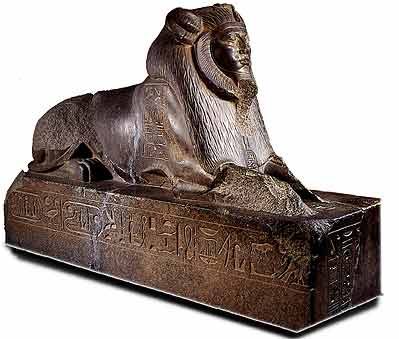
|
Two colossal statues
of Amenemhet III (left) were erected at Biyahmu to commerate
his achievement (the high bases were discovered by Petrie).
The final few years of Amenemhet III's reign were spent in co-rule
with his son, Amenemhet IV.
The Labyrinth
of Amenemhet III
On the south of Amenemhet
III's second pyramid, a tremendous structure was built - his
mortuary temple. When classical writers visited this building
(1000 x 800ft - 305 x 244m) they referred to its huge number
of rooms as a great Labyrinth.
Sadly very little remains
of this structure - the site has been virtually completely destroyed
over the centuries (when Petrie discovered the site in 1888-9
he had great difficulty in finding any real architecture to match
the description given from ancient times.
|
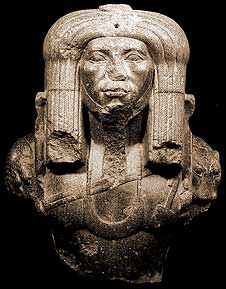 |
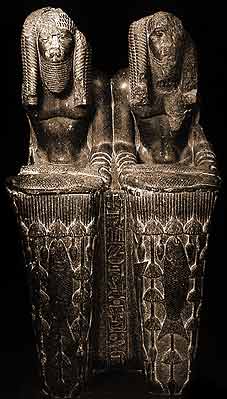 |
Herodotus
on the Labyrinth:
"To
strengthen the bond between them, they decided to leave a common
memorial of their reigns, and for this purpose constructed a
labyrinth a little above Lake Moeris, near the place called the
City of Crocodiles. I have seen this building, and it is beyond
my power to describe; it must have cost more in labour and money
than all the walls and public works of the Greeks put together
- though no one would deny that the temples at Ephesus and Samos
are remarkable buildings. The pyramids, too, are astonishing
structures, each one of them equal to many of the most ambitious
works of Greece; but the labyrinth surpasses them. It has twelve
covered courts - six in a row facing north, six south - the gates
of the one range exactly fronting the gates of the other, with
a continuous wall round the outside of the whole. Inside, the
building is of two storeys and contains three thousand rooms,
of which half are underground, and the other half directly above
them. I was taken through the rooms in the upper storey, so what
I shall say of them is from my own observation, but the underground
ones I can speak of only from report, because the Egyptians in
charge refused to let me see them, as they contain the tombs
of the kings who built the labyrinth, and also the tombs of the
sacred crocodiles. The upper rooms, on the contrary, I did actually
see, and it is hard to believe that they are the work of men;
the baffling and intricate passages from room to room and from
court to court were an endless wonder to me, as we passed from
a court-yard into rooms, from rooms into galleries, from galleries
into more rooms, and thence into yet more courtyards. The roof
of every chamber, courtyard, and gallery is, like the walls,
of stone. The walls are covered with carved figures, and each
court is exquisitely built of white marble and surrounded by
a colonnade. Near the corner where the labyrinth ends there is
a pyramid, two hundred and forty feet in height, with great carved
figures of animals on it and an underground passage by which
it can be entered".
|
The Pyramids of Amenemhet
III
(Amenemehet III
built two pyramids - one at Dahshur, and the second at Hawara)
The
Pyramid of Amenemhet III at Dahshur
(the
Black Pyramid)
Original
Height - 81.5 m
Length
of Side - 105m
|
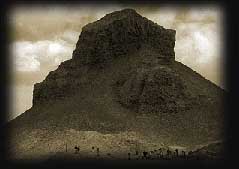 |
His first Pyramid
the pyramid at Dahshur, it's name 'Black Pyramid' comes
from the dark materials it was built with (unfired brick and
basalt).
This pyramid was first excavated by Jaques De Morgan in 1894-5,
he found the pyramidion (which originally topped the pyramid)
amongst the rubble at the base of the pyramid. Once inside the
pyramid, De Morgan found the sarcophagus originally intended
for Amenemhet III - made from pink granite.
Jack Hawkins - Land of the Pharaohs.
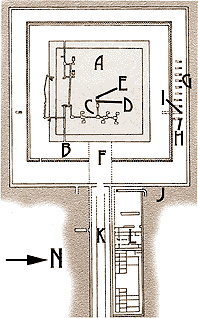 |
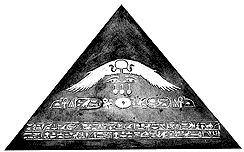 (the
pyramidion which originally topped the pyramid)
(the
pyramidion which originally topped the pyramid)
| A - Pyramid |
G - Burial
shafts of Kings and Princes |
| B - Entrance |
H - Burial
shaft of King Hor-Auibra (13th Dynasty) |
| C - Funerary
Apartment |
I - Tomb
of Princess Nubhotep |
| D - Burial
Chamber |
J - Enclosure
wall |
| E - Sarcophagus |
K - Processional
Ramp |
| F - Remains
of Funerary Temple |
L
- Remains of residential buildings |
|
The
Pyramid of Amenemhet III at Hawara
Original
Height - 58 m
Length
of Side - 100m
|
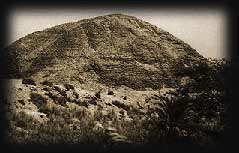 |
Amenemhet III's second
pyramid and the last big pyramid which was to be built in Egypt.
It was built from unfired brick and was covered with limestone
slabs. The Labyrinth / Funerary Temple is now reduced to strange
muddy heaps which can only just show that an ancient building
once stood beside the pyramid. Two sarcophagi were discovered
inside the pyramid - the larger was made from quartzite, a smaller
sarcophagus was also found but the identity of the owner remains
unknown.
 |
| A - Pyramid |
D - Burial
Chamber |
| B - Entrance |
E - North
Chapel |
| C - Corridor |
F - Remains
of Funerary Temple - More comonly known as the "Labyrinth"
- see above |
|
In 1965 the tomb of Princess
Neferuptah was discovered (2km south of the pyramid). Her funerary
treasure was also found - including - a collar made from golf
and semi-precious stones, and a ritual scourge made from gold
and semi-precious stones.
While working in a Graeco-Roman
necropolis north of the pyramid in 1888, Petrie discovered the
'Faiyum Portraits'.
|



